Your Cart is Empty
Menu

How Long Does An E-Bike Battery Last?
July 27, 2025

Like the fuel that powers a car or the energy in your morning coffee, an e-bike battery is the lifeblood of your ride. It holds immense power and potential, just waiting to be unleashed. But how long can this mighty battery last? That's a question every e-biker asks at some point.
Key Takeaways:
- An e-bike battery typically lasts between 3 to 5 years or around 500 to 1000 charge cycles.
- Battery performance and longevity are influenced by temperature extremes, terrain, rider weight, charging behavior, storage practices, and the quality of the battery management system (BMS).
- Proper charging, storage, and health monitoring can extend battery life.
In this article, we will explore the factors influencing an e-bike battery's lifespan and reveal how long it can endure before recharging. We'll also dive into techniques for monitoring battery health and extending its lifespan.
Understanding E-Bike Batteries
When it comes to understanding e-bike batteries and how long they last, there are two key points to consider. Firstly, the type of battery used in an e-bike plays a significant role in determining its lifespan. Secondly, several components can affect the overall battery life, such as the motor power, terrain conditions, rider weight, and usage patterns.

Types of E-Bike Batteries
E-bike batteries come in various types, each with its characteristics and advantages. The most common and widely used type is the Lithium-ion (Li-ion) battery.
Lithium-ion Batteries
Lithium-ion batteries are favored for their high energy density, lightweight construction, and long lifespan. They are commonly used in modern e-bikes due to their efficiency and ability to provide a significant range per charge. With the ability to provide a substantial range per charge, these batteries have become the industry standard, combining reliability and performance for a superior riding experience.
Nickel-Cadmium Batteries
Nickel-cadmium (NiCd) batteries, although less common in contemporary e-bikes, were once popular for their durability and resilience to extreme temperatures. However, the rise of Lithium-ion technology has overshadowed NiCd batteries due to their heavier weight, lower energy density, and environmental concerns associated with cadmium. Modern e-bikes mostly opt for Lithium-ion batteries, emphasizing efficiency and sustainability.
Lead-acid Batteries
While less prevalent in today's e-bike landscape, lead-acid batteries remain a cost-effective option. These batteries are characterized by their lower energy density, shorter lifespan, and heavier build compared to Lithium-ion counterparts.
Lead-acid batteries are often found in older or budget-friendly electric bikes where cost considerations outweigh the desire for the lighter weight and longer lifespan offered by more advanced battery technologies. As the industry continues to evolve, Lithium-ion batteries dominate, offering superior performance and efficiency for e-bike enthusiasts.
Here's a simple data table outlining the pros and cons of different e-bike battery types:
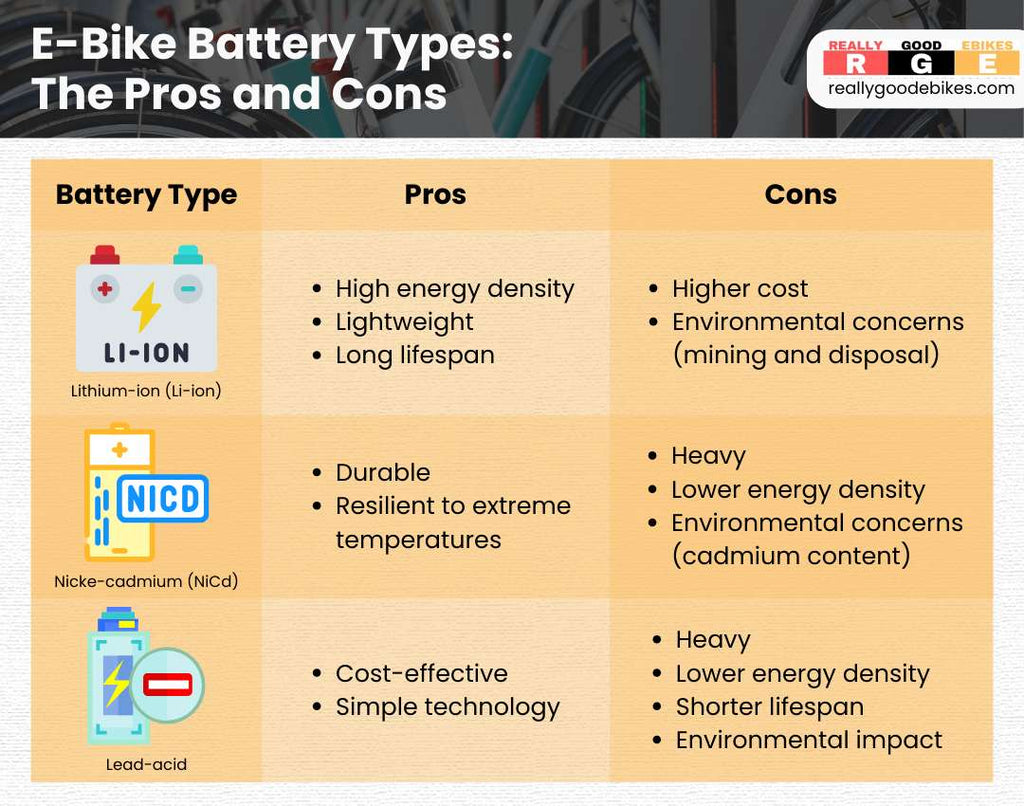
Components Affecting Battery Life
Regarding the components that affect battery life on an e-bike, two key factors are the battery management system (BMS) and charging cycles.
Battery Management System (BMS)
The battery management system (BMS) is crucial for optimizing the lifespan of an e-bike battery. It plays a vital role in monitoring and controlling battery performance, longevity, maintenance, efficiency, and technology.
The BMS ensures that the battery operates within safe limits by regulating factors such as charging rates, temperature, and voltage levels. By carefully managing these aspects, the BMS helps extend the overall lifespan of the e-bike battery while maximizing its efficiency and performance.
You might be interested to learn about affordable adult 80 volt electric bikes.
Charging Cycles
Charging cycles refer to the number of times you charge and discharge your battery. Each cycle contributes to the wear and tear of the battery, eventually leading to a decrease in its capacity.
By properly managing your charging cycles, you can extend the lifespan of your battery and delay the need for a replacement. It's important to note that charging time, battery maintenance, and following manufacturer guidelines also maximize battery efficiency and maintain its warranty.
Make every charge count. Find your perfect B.O.B. Electric Bike today!
Factors Influencing E-Bike Battery Lifespan
When it comes to the lifespan of your e-bike battery, there are several key factors to consider. First and foremost is the impact of temperature and climate. Extreme heat or cold can significantly affect your battery's performance and overall lifespan.
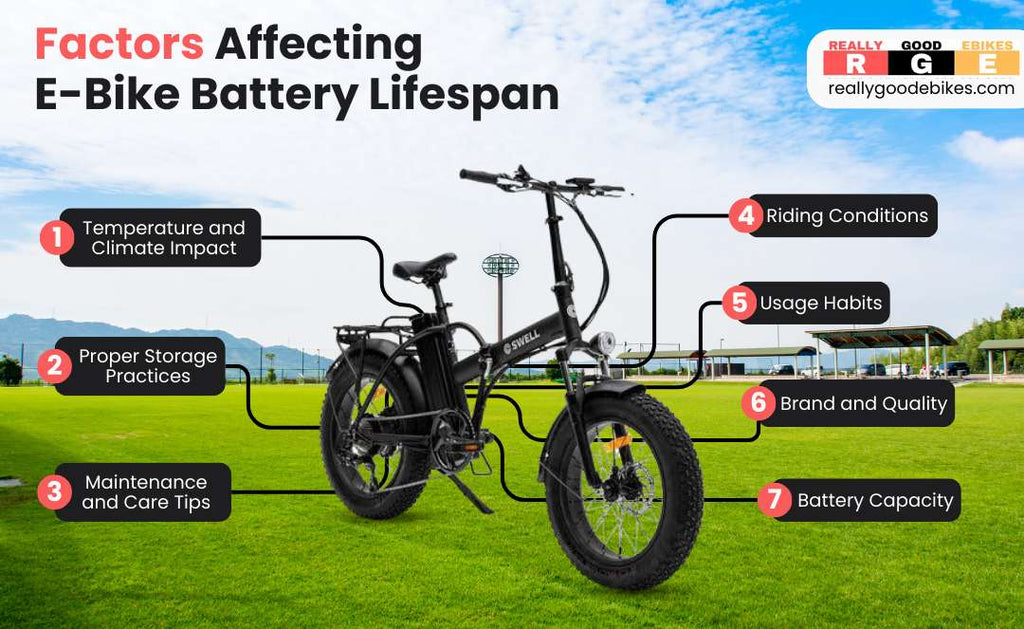
Temperature and Climate Impact
Extreme temperatures can have a serious impact on your e-bike battery’s performance and lifespan. High heat accelerates battery cell degradation, while cold weather reduces power output and shortens range due to slower chemical reactions inside the battery.
To protect your battery, store your e-bike in a cool, dry place whenever possible. Avoid leaving it out in harsh weather—direct summer sun orfreezing winter conditions can shorten battery life significantly.
Proper Storage Practices
Storing your e-bike correctly is essential for maintaining battery health over time. Choose a location that’s cool, dry, and away from temperature extremes to help prevent premature wear. Before long-term storage, charge the battery to around 50% to avoid deep discharge, and consider removing it from the bike to prevent unnecessary drain or vibration damage during transport or handling.
Battery Capacity
Battery capacity is the total amount of energy your battery can store and directly impacts range and performance. Most e-bikes use lithium-ion batteries, which are known for their high energy density and long life cycle.
To protect capacity, avoid deep discharges, extreme temperatures, and improper charging habits. Following regular maintenance and smart charging practices will help extend your battery’s useful life.
Riding Conditions
How and where you ride affects how quickly your battery drains. Steep hills, rough terrain, and heavy rider loads require more power, which reduces overall battery range.
Weather also matters—strong headwinds or extreme temperatures can make your motor work harder. Choosing flatter routes and riding in mild weather can help your battery last longer between charges.
Usage Habits
Smart usage habits can make a big difference in how long your e-bike battery lasts. Switching to manual mode on flat terrain and using pedal assist wisely reduces battery strain.
Keep an eye on your battery for any signs of wear, like corrosion or loose connections, and remember—even with great care, batteries have a limited lifespan. Regular maintenance helps you get the most out of every charge.
Brand and Quality
Battery quality varies widely, so choosing a reputable brand is worth the investment. A high-quality battery will last longer, perform more consistently, and require fewer replacements over time.
Better batteries also handle weather changes and rough terrain more reliably, retaining their capacity and performance longer. Trusted brands offer peace of mind and a smoother, longer-lasting riding experience.
Maintenance and Care Tips
To keep your e-bike battery in top shape, aim to keep the charge level between 20% and 80%, which helps extend its overall lifespan. Avoid exposing the battery to extreme heat or cold, as this can reduce performance over time. Regularly clean the battery with a soft cloth and mild detergent to prevent dirt buildup that could affect connections.
If you notice sudden power loss or reduced range, check for loose wires or poor contact with the charger. Basic troubleshooting can fix minor issues, but if problems persist, it’s best to consult a technician. To avoid battery problems and maximize battery life, use pedal-assist when possible, avoid full discharges, and recharge before it's completely drained. When replacement is needed, you can choose between original manufacturer batteries or cost-effective aftermarket options with matching specs.
In this video, let's look at some helpful tips that can help keep your e-bike battery in the best health.
So, How Long Does an E-Bike Battery Typically Last?
Typically, an e-bike battery lasts for around 3-5 years before it needs to be replaced. Understanding the efficiency of an e-bike battery is crucial in optimizing its lifespan.
To ensure your battery lasts as long as possible, it's important to charge it properly and avoid overcharging or discharging it completely. Regularly monitoring the battery's health and maintaining a consistent charging routine can help extend its lifespan.
Battery range estimation is another key aspect to consider when discussing how long an e-bike battery lasts. The range of an e-bike battery depends on various factors such as terrain, rider weight, and assist level used. Manufacturers typically provide estimates based on average conditions, but individual experiences may vary.
When purchasing an e-bike, it's essential to inquire about the battery warranty coverage offered by the manufacturer. Different brands have different warranty policies, so understanding what is covered and for how long can be beneficial in case any issues arise with the battery during its expected lifespan.
Additionally, many manufacturers now promote sustainable practices by offering recycling programs for old e-bike batteries.
While the average lifespan of the best e-bike battery ranges from 3-5 years, understanding efficiency optimization techniques, considering range estimation factors, being aware of warranty coverage options, and participating in recycling initiatives can help maximize its longevity.
How to Monitor E-Bike Battery Health
Various tools and apps are available to monitor your e-bike battery's health. These tools and apps provide detailed information about your battery's current state, including its capacity, voltage, and charging cycles.
Tools and Apps for Monitoring Battery Health
You'll be amazed at the wide array of tools and apps available to keep an eye on your e-bike battery's health. Battery monitoring is made easy with these innovative solutions that offer real-time insights into your battery's performance.
Generic e-bike monitoring apps such as EBike Connect provide real-time data on battery status and range estimation for various systems. Third-party apps like MyEnergi Platform or battery level indicator apps like Battery Life for iOS offer compatibility with diverse e-bike systems.
With battery diagnostics, you can also uncover potential issues or anomalies before they become major problems. Battery tracking allows you to monitor your battery's overall lifespan, giving you a clear understanding of when it might need replacement.
Additionally, these tools provide valuable data on battery performance, helping you optimize its usage and maximize its lifespan. Whether through detailed graphs and charts or personalized notifications, these tools ensure you never have to worry about your e-bike battery's health again.
Signs of a Declining E-Bike Battery
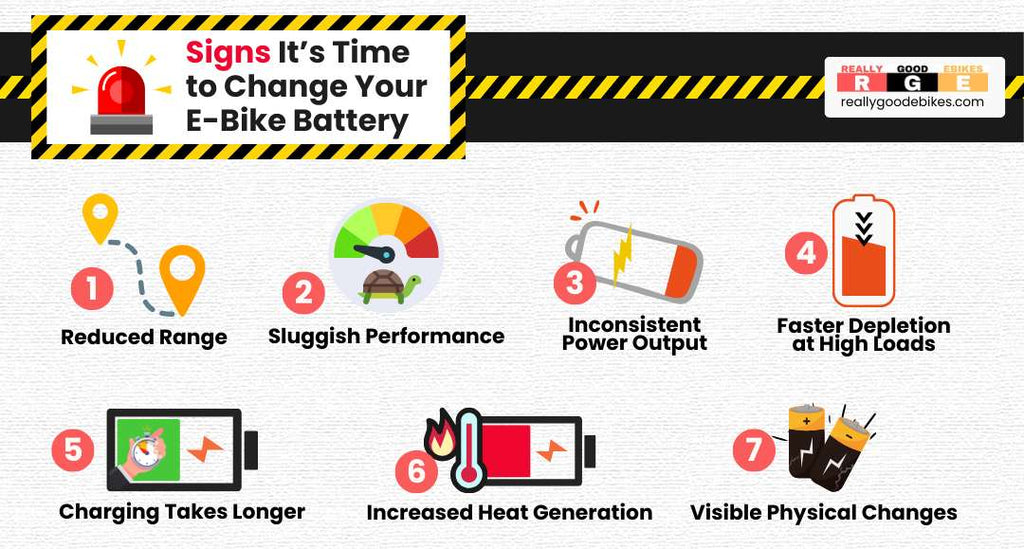
One clear indication that your e-bike battery is starting to decline is when it no longer holds a charge for as long as it used to. This decrease in battery performance can be attributed to factors such as battery degradation and capacity loss over time.
As the battery goes through charging cycles, its ability to store energy gradually diminishes. Monitoring these signs of declining battery health is important because they can affect your overall riding experience. Using tools and apps designed for monitoring battery health, you can estimate the remaining lifespan of your e-bike battery and determine when it may need replacement.
Extending E-Bike Battery Lifespan
To extend the lifespan of your e-bike battery, it's important to follow charging best practices.
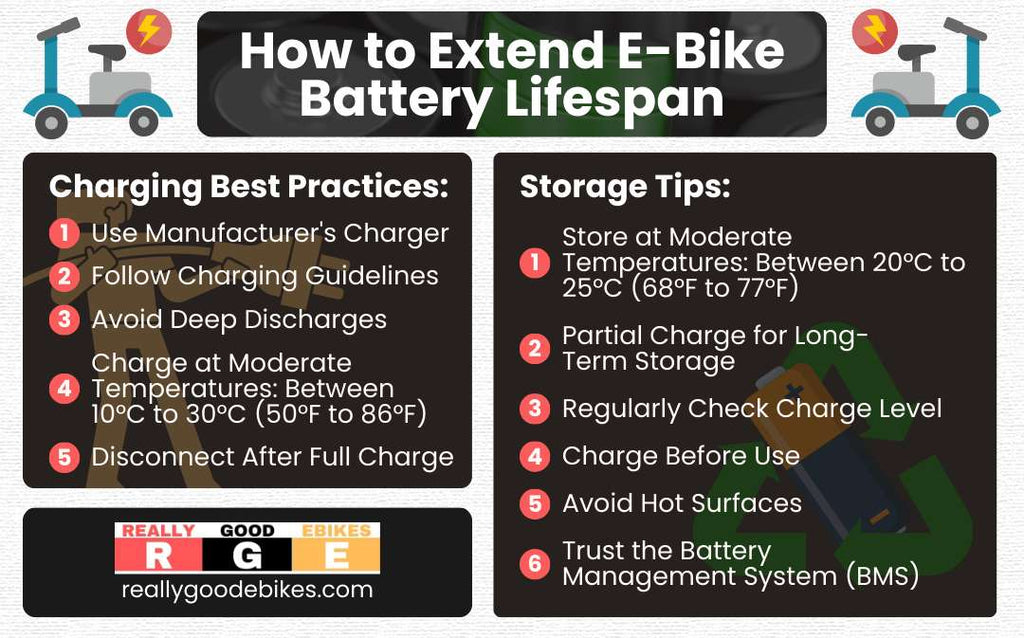
Charging Best Practices
There are several best practices to follow to maximize charging efficiency and optimize battery lifespan.
First, always use the charger specifically designed for your e-bike model. Using the wrong charger can lead to overcharging risks and potentially damage the battery cells.
Additionally, avoid leaving your e-bike connected to the charger for extended periods after reaching full charge, as this can shorten the battery's lifespan. It's recommended to unplug the charger promptly once charging is complete.
Furthermore, regular battery maintenance is crucial for optimal performance and longevity. This includes keeping the contacts clean and periodically checking for any signs of wear or damage.
Storage Tips for Prolonged Periods of Inactivity
If you want to keep your e-bike battery in top condition during periods of inactivity, here's a handy storage tip.
Proper maintenance and storage are essential for preventing battery degradation and ensuring longevity. To preserve your battery, start charging it to around 50% before storing it. This helps prevent over-discharge or overcharging during prolonged periods of inactivity.
It's also important to store the battery in a cool, dry place away from direct sunlight or extreme temperatures. Avoid exposing it to moisture or placing heavy objects on top of it, as this can damage the cells inside.
Additionally, check the battery regularly and recharge it every few months to maintain optimal performance.
Fast Charging: Convenience vs. Battery Longevity
As e-bike technology advances, fast charging has become a desirable feature for riders who want to get back on the road quickly. However, the speed of charging comes with trade-offs. While fast chargers offer undeniable convenience—especially for commuters and long-distance riders—they may also accelerate battery degradation if used frequently. Understanding the balance between speed and long-term battery health is crucial to making informed decisions about when and how to use fast charging.

Pro Diagnostics and Servicing
Apps are great for giving you a basic snapshot of your e-bike battery’s health, but if you really want to get into the details, it’s worth turning to the pros. They can go beyond surface-level readings—checking things like individual cell voltages, balancing the cells, and measuring internal resistance (which shows how well your battery delivers power).
They can also handle important tasks like updating your Battery Management System (BMS) firmware or recalibrating it if the readings seem off. Since working with battery packs involves high voltage, it’s best to leave the deep-dive stuff to certified technicians.
Comparison with Other Transportation Modes
Compared to other transportation options, e-bike batteries offer impressive longevity and allow for worry-free exploration. Unlike cars that require regular refueling or lengthy charging sessions, a fully charged e-bike battery can deliver hours of consistent use—perfect for daily commutes or longer rides.
Modern e-bikes can now travel up to 100 miles on a single charge, depending on factors like terrain and rider weight, helping eliminate the “range anxiety” often associated with electric vehicles. They're also more environmentally friendly, producing zero emissions and consuming far less energy than cars, which translates into both a smaller carbon footprint and lower charging costs. Over time, the savings on fuel and maintenance make e-bikes a highly cost-effective alternative to car ownership.
Future Developments in E-Bike Batteries
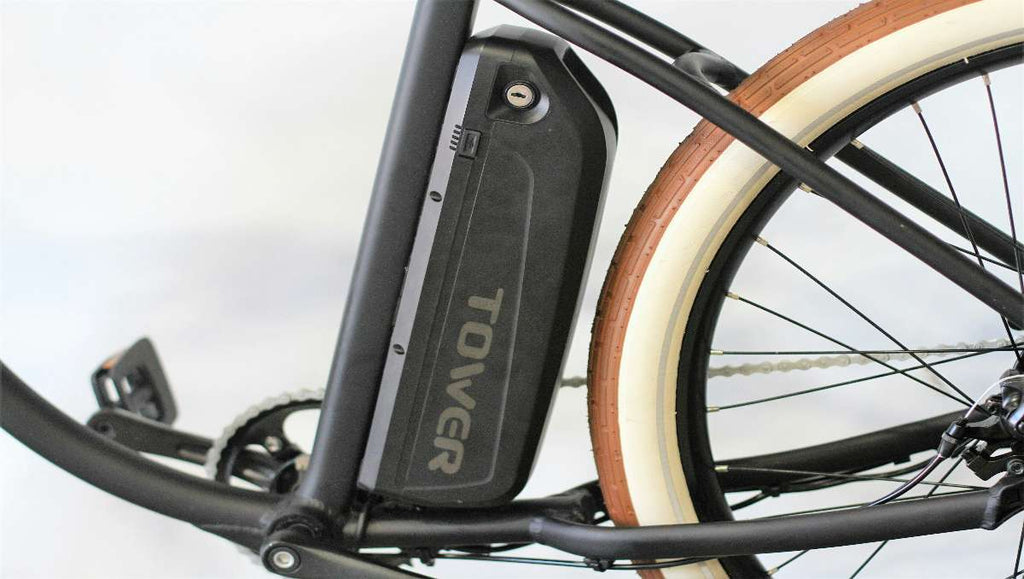
The future of e-bike batteries is centered around improving efficiency, range, and sustainability. Manufacturers are working on technologies that store more energy while using less power, making e-bikes even more eco-friendly and allowing riders to travel longer distances on a single charge.
Increasing power density is another exciting development—this means packing more energy into smaller, lighter batteries without sacrificing performance. In addition, faster charging solutions and expanded charging infrastructure are on the horizon, making it easier for riders to stay powered up wherever they go. These innovations promise a smoother, more powerful riding experience while supporting a greener future.
Giving Old E-Bike Batteries a Second Life (or a Proper Send-Off)
Just because your e-bike battery doesn’t hold a full charge anymore doesn’t mean it’s useless. Many still have 60–80% of their capacity left and can be reused for things like home energy backup, portable chargers, or solar-powered lights. It’s a smart way to get more use out of the battery—and it helps cut down on electronic waste.
Of course, every battery reaches the end of the road eventually. When that happens, recycling is the way to go. Big names like Bosch and Shimano work with certified programs to safely break down batteries and recover materials like lithium and nickel. It’s safer for the environment and helps reduce the need to mine new materials.
Ready to extend your ride? Discover high-quality e-bike batteries that go the distance and power your adventures further.
Sustainable Rides: E-Bike Battery Lifespan Unveiled
In conclusion, your e-bike battery is like the life force that fuels your ride. It has the power to take you on countless adventures and journeys. However, just like any other energy source, its lifespan can be influenced by various factors.
By understanding how long an e-bike battery lasts and taking steps to monitor and extend its health, you can ensure a longer-lasting and more efficient ride. As advancements continue in e-bike technology, we can expect even greater improvements in battery longevity for a future of limitless possibilities.
Frequently Asked Questions
1. How long does an e-bike battery last when fully charged?
A fully charged e-bike battery typically lasts between 25 to 70 miles (40 to 110 km) depending on various factors like terrain, rider weight, assistance level, and battery capacity. High-capacity batteries and eco riding modes can extend range, while hills, wind, and heavy loads can shorten it.
2. How much does it cost to replace the battery in an e-bike?
Replacement e-bike batteries generally cost between $300 to $900 USD, depending on the brand, voltage, and capacity. Premium systems like Bosch or Shimano tend to be on the higher end, while generic or off-brand batteries may cost less—but might compromise on safety or performance.
3. Can I replace just the cells instead of buying a new battery?
Yes, re-celling an e-bike battery—replacing the individual lithium-ion cells—is technically possible and often cheaper than buying a new battery. However, it requires specialized knowledge and equipment, and should only be done by certified battery repair professionals to avoid safety risks and voiding warranties.
4. Do all e-bike batteries lose capacity at the same rate?
No, battery degradation rates vary based on battery chemistry, brand quality, usage habits, and charging behavior. High-quality lithium-ion batteries with proper care tend to degrade more slowly, while frequent fast charging, deep discharges, and poor storage can accelerate capacity loss.
2 Responses

Hemant
October 31, 2025
Just finished reading your article on e-bike battery lifespan, and I have to say, it’s incredibly informative! As someone who’s considering investing in an e-bike, battery life was a big concern for me, so stumbling upon your blog post was perfect timing.
Your breakdown of the factors affecting battery lifespan was spot-on. I had no idea that temperature and charging habits could have such a significant impact. And the tips you provided for extending battery life were super practical—I’ll definitely be implementing those once I get my hands on an e-bike.
Overall, thanks for shedding light on such an important aspect of e-bike ownership. Your expertise and clear explanations make navigating the world of e-bikes much less intimidating. Keep up the great work! 🙌
Leave a comment
Comments will be approved before showing up.
Also in Really Good Ebikes: Electric Bike Blog
Your are successfully subscribed for email notifications.
Notify me when available
We will send you a notification as soon as this product is available again.
Your email is required
We don't share your email with anybody
x



carbattery nz
October 31, 2025
Wonderful, insightful article! It clearly explains how long e‑bike batteries last, lifespan factors, and maintenance tips in simple, practical terms.